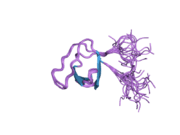EPS8L2
| EPS8L2 | |||||||||||||||
|---|---|---|---|---|---|---|---|---|---|---|---|---|---|---|---|
 | |||||||||||||||
| |||||||||||||||
| Identifiers | |||||||||||||||
| Aliases | EPS8L2, EPS8R2, EPS8 like 2 | ||||||||||||||
| External IDs | MGI: 2138828 HomoloGene: 69358 GeneCards: EPS8L2 | ||||||||||||||
| RNA expression pattern | |||||||||||||||
 | |||||||||||||||
| More reference expression data | |||||||||||||||
| Orthologs | |||||||||||||||
| Species | Human | Mouse | |||||||||||||
| Entrez | |||||||||||||||
| Ensembl | |||||||||||||||
| UniProt | |||||||||||||||
| RefSeq (mRNA) | |||||||||||||||
| RefSeq (protein) | |||||||||||||||
| Location (UCSC) | Chr 11: 0.69 – 0.73 Mb | Chr 7: 141.34 – 141.36 Mb | |||||||||||||
| PubMed search | [1] | [2] | |||||||||||||
| Wikidata | |||||||||||||||
| |||||||||||||||
Epidermal growth factor receptor kinase substrate 8-like protein 2 is an enzyme that in humans is encoded by the EPS8L2 gene.[3][4]
This gene encodes a protein that is related to epidermal growth factor receptor pathway substrate 8 (EPS8), a substrate for the epidermal growth factor receptor. The function of this protein is unknown.[4]
References
- ↑ "Human PubMed Reference:".
- ↑ "Mouse PubMed Reference:".
- ↑ Tocchetti A, Confalonieri S, Scita G, Di Fiore PP, Betsholtz C (Mar 2003). "In silico analysis of the EPS8 gene family: genomic organization, expression profile, and protein structure". Genomics. 81 (2): 234–44. PMID 12620401. doi:10.1016/S0888-7543(03)00002-8.
- 1 2 "Entrez Gene: EPS8L2 EPS8-like 2".
Further reading
- Maruyama K, Sugano S (1994). "Oligo-capping: a simple method to replace the cap structure of eukaryotic mRNAs with oligoribonucleotides.". Gene. 138 (1-2): 171–4. PMID 8125298. doi:10.1016/0378-1119(94)90802-8.
- Suzuki Y, Yoshitomo-Nakagawa K, Maruyama K, et al. (1997). "Construction and characterization of a full length-enriched and a 5'-end-enriched cDNA library.". Gene. 200 (1-2): 149–56. PMID 9373149. doi:10.1016/S0378-1119(97)00411-3.
- Strausberg RL, Feingold EA, Grouse LH, et al. (2003). "Generation and initial analysis of more than 15,000 full-length human and mouse cDNA sequences.". Proc. Natl. Acad. Sci. U.S.A. 99 (26): 16899–903. PMC 139241
 . PMID 12477932. doi:10.1073/pnas.242603899.
. PMID 12477932. doi:10.1073/pnas.242603899. - Offenhäuser N, Borgonovo A, Disanza A, et al. (2004). "The eps8 family of proteins links growth factor stimulation to actin reorganization generating functional redundancy in the Ras/Rac pathway.". Mol. Biol. Cell. 15 (1): 91–8. PMC 307530
 . PMID 14565974. doi:10.1091/mbc.E03-06-0427.
. PMID 14565974. doi:10.1091/mbc.E03-06-0427. - Ota T, Suzuki Y, Nishikawa T, et al. (2004). "Complete sequencing and characterization of 21,243 full-length human cDNAs.". Nat. Genet. 36 (1): 40–5. PMID 14702039. doi:10.1038/ng1285.
- Gerhard DS, Wagner L, Feingold EA, et al. (2004). "The status, quality, and expansion of the NIH full-length cDNA project: the Mammalian Gene Collection (MGC).". Genome Res. 14 (10B): 2121–7. PMC 528928
 . PMID 15489334. doi:10.1101/gr.2596504.
. PMID 15489334. doi:10.1101/gr.2596504. - Wan D, Gong Y, Qin W, et al. (2004). "Large-scale cDNA transfection screening for genes related to cancer development and progression.". Proc. Natl. Acad. Sci. U.S.A. 101 (44): 15724–9. PMC 524842
 . PMID 15498874. doi:10.1073/pnas.0404089101.
. PMID 15498874. doi:10.1073/pnas.0404089101. - Kim JE, Tannenbaum SR, White FM (2005). "Global phosphoproteome of HT-29 human colon adenocarcinoma cells.". J. Proteome Res. 4 (4): 1339–46. PMID 16083285. doi:10.1021/pr050048h.
This article is issued from
Wikipedia.
The text is licensed under Creative Commons - Attribution - Sharealike.
Additional terms may apply for the media files.

